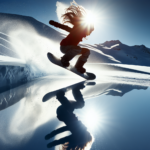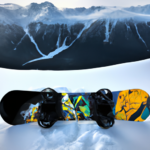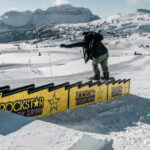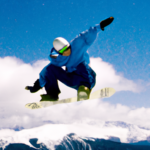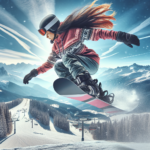If you’re looking for ways to improve your snowboarding skills and impress your friends on the slopes, then learning how to press a snowboard could be key. This article walks you through the step-by-step process, making it simple and easy for you to understand the art of the snowboard press. Perfect press execution means smoother movement and transition, a crucial skill for those interested in freestyle snowboarding. We’re confident that this guide would be your go-to manual for landing a perfect press.
Understanding Snowboard Pressing
Snowboarding incorporates an array of maneuvers and styles, one of the most essential among them is press. It’s a technique where you shift your weight towards the nose or tail of your board, elevating the opposite end.
What is snowboard pressing?
Snowboard pressing, simply referred to as a press, involves leaning or shifting your weight towards the nose or tail of your snowboard. This action raises the other end off the ground, creating a teeter-totter effect. Presses make for dynamic rides, and add an element of style and fluidity to your moves.
Importance of snowboard pressing
Pressing is an integral part of freestyle snowboarding. It’s often used to prepare for or pull off more complex tricks. Pressing demonstrates your board control and balance. Plus, they add style to your riding – smooth presses, when performed with ease and fluidity, are aesthetically pleasing.
Factors affecting the press
Pressing requires a blend of stability, strength, and approach. Your snowboard’s size, shape, and flexibility play a key role, as does your individual style. Weight distribution, board positioning, and speed are all crucial elements.
Types of Snowboard Presses
Snowboard presses take various forms, each having its unique appeal and application.
Nose Press
A nose press entails shifting your weight onto the front foot, lifting the tail high off the ground.
Tail Press
Tail press is the inverse of nose press. Here, the weight is shifted onto the back foot, which lifts the nose high off the ground.
Ollie Press
In an ollie press, you spring off your tail to get airborne. It’s a common trick in snowboarding and a prerequisite for many other tricks.
Nollie Press
A nollie press is the opposite of the ollie press. Here, you spring off your nose to lift the tail off the snow.
Preparing for a Snowboard Press
Before attempting a press, ensure you are appropriately prepared.
Choosing the right snowboard
It’s crucial to have the correct snowboard. Generally, a softer or more flexible board will make presses easier. The ideal size is typically slightly shorter than your regular ride.
Warming up and stretches
As with any high-intensity sport, warm-ups and stretches are pivotal. They similarly hold true for snowboarding, as they loosen your body and pre-empt potential injuries.
The right terrain
Start practicing presses on a flat terrain before moving on to slopes and ramps. A gentle slope will keep you moving without requiring a lot of speed.
Performing a Nose Press
Positioning and basic movement
Begin with your usual stance, then shift your weight onto the front foot. At the same time, lean your upper body slightly backward to maintain balance.
Lifting the tail
Push down hard on your front foot and lift the tail of your board high. Keep your back knee bent and your back foot loose to elevate the tail further.
Maintaining the press
Keeping the tail elevated requires constant pressure on your front foot. Ensure your body maintains stability and balance throughout.
Exiting the press
Exit the press by gently transferring weight back to your back foot. Take care not to lean backwards suddenly, as it could cause a fall.
Performing a Tail Press
Initial positioning
Start in your normal stance. Now, shift your weight onto the back foot while maintaining a bend in your front knee. Lean slightly forward to counterbalance.
Lifting the nose
Amplify pressure on your rear leg and pull up your front foot to raise the nose. Your front knee should be loose and bent.
Sustaining the tail press
Maintaining the nose raised requires a solid stance on the tail of your board. Stability, balance, and continuous pressure are all necessary.
Exiting the press
To exit, gradually shift your weight back to the front foot. Refrain from moving too quickly, as instability could ensue.
Safety While Pressing a Snowboard
Safety is pivotal when practicing snowboard presses. Make sure to equip yourself with the right gear and knowledge of common injuries.
Safety gear
Snowboarding inherently carries risk of injuries. Ensure you’re wearing a helmet, wrist guards, and snowboarding-appropriate clothing. Knee and back protectors are also recommended.
Common pressing injuries
Like any snowboarding move, presses can result in falls or injuries. Common ones include sprains, dislocated joints, and concussions. Training and proper technique can mitigate these odds.
Tips to avoid injuries
Controlled speed, balance, and proper technique are instrumental to prevent injuries. Always listen to your body’s cues and never push past your limits.
When to avoid pressing?
Avoid pressing if you’re tired or physically unable to maintain balance. Also, refrain from pressing on very steep slopes or unstable terrain.
Troubleshooting Common Pressing Mistakes
Despite your best efforts, you may encounter inconsistencies or problems while pressing.
Common problems
These could range from insufficient elevation of the nose or tail, wobbling, or inability to maintain the press. Sometimes, you may lean too far forward or backward.
Adjusting technique
In such cases, determine the cause and adjust your technique accordingly. This could involve refining your stance, redistributing weight, or adjusting speed.
Practice exercises
There are many exercises to improve pressing technique. Balance board workouts, squats for leg strength, or yoga for flexibility, can all be beneficial.
Combining Presses with Tricks
Presses form the foundation for numerous snowboarding tricks.
Press to spin
You can utilize the momentum from a press to spin mid-air or on the ground.
Press to grab
Grabs can be added to a press for extra flair. You can reach down and grab your board mid-press.
Press to slide
Presses can be incorporated into slides on rails and boxes, making for a smooth ride and appealing visuals.
Press combinations
Experiment with pairing different presses together for impressive sequences. Combining a nose and tail press, for instance, can create a stylish rocking effect.
Progressing Your Pressing Skills
With consistent practice, you can improve your pressing technique.
Advanced pressing techniques
These might include pressing while moving at high speeds or incorporating presses into mid-air tricks.
Building balance and control
Greater balance and control enable you to press the board higher and longer. They also help to pull-off complex maneuvers with precision.
Transitioning to bigger features
As you gain confidence, you can attempt presses on larger features, such as jumps or rails.
Caring For Your Snowboard After a Press
Presses can cause wear and tear on your board. Regular upkeep will ensure your board lasts longer and performs better.
Potential damage from pressing
Pressing can put undue strain on your snowboard, leading to scratches, chips, or dents. Over time, it can affect your board’s flexibility and performance.
Regular snowboard maintenance
Frequent waxing and edge tuning will keep your snowboard in prime form. Checking for and repairing any damage after each snowboarding session can be beneficial.
Post-press board inspection
Always inspect your snowboard after pressing, particularly the nose and tail. Look for any delamination or cracks. Regular check-ups can catch damage before it becomes severely detrimental.
- What Snowboard Bindings Should I Get? - January 23, 2024
- What Size Screws For Snowboard Bindings? - January 23, 2024
- How To Snowmobile On Water? - January 23, 2024


